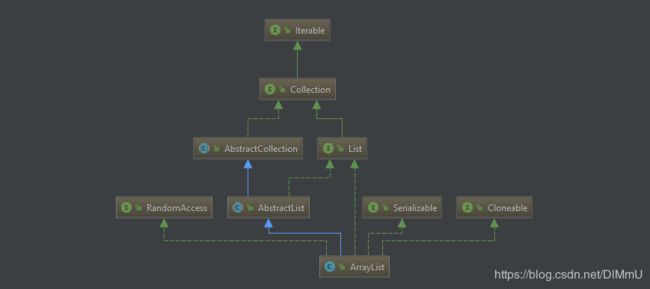源码角度分析Java ArrayList为什么是线程不安全的
面试中一个经常被问到的问题就是:ArrayList是否是线程安全的?
答案当然很简单,无论是背来的还是自己看过源码,我们都知道它是线程不安全的。那么它为什么是线程不安全的呢?它线程不安全的具体体现又是怎样的呢?我们从源码的角度来看下。
public class ArrayList<E> extends AbstractList<E>
implements List<E>, RandomAccess, Cloneable, java.io.Serializable
{
private static final long serialVersionUID = 8683452581122892189L;
/**
* default capacity:默认初始大小为10
*/
private static final int DEFAULT_CAPACITY = 10;
/**
* 用于空实例的共享空数组实例。
*/
private static final Object[] EMPTY_ELEMENTDATA = {};
/**
* Shared empty array instance used for default sized empty instances. We
* distinguish this from EMPTY_ELEMENTDATA to know how much to inflate when
* first element is added.
*/
private static final Object[] DEFAULTCAPACITY_EMPTY_ELEMENTDATA = {};
/**
* 存储ArrayList的元素的数组缓冲区。
* ArrayList的容量是此数组缓冲区的长度. 任何包含elementData的空ArrayList ==
* 添加第一个元素时,DEFAULTCAPACITY_EMPTY_ELEMENTDATA将扩展为DEFAULT_CAPACITY.
*/
transient Object[] elementData; // non-private to simplify nested class access
/**
* ArrayList的大小(它包含的元素数)。
*
* @serial
*/
private int size;
}

所以通过这两个字段我们可以看出,ArrayList的实现主要就是用了一个Object的数组,用来保存所有的元素,以及一个size变量用来保存当前数组中已经添加了多少元素。
接着我们看下最重要的add操作时的源代码:
/**
* 添加一个元素时,做了如下两步操作
* 1.判断列表的capacity容量是否足够,是否需要扩容
* 2.真正将元素放在列表的元素数组里面
*/
public boolean add(E e) {
ensureCapacityInternal(size + 1); // Increments modCount!!(确认有线程正在更改数组)
elementData[size++] = e;
return true;
}
/**
* 判断如果将当前的新元素加到列表后面,列表的elementData数组的大小是否满足,
* 如果size + 1的这个需求长度大于了elementData这个数组的长度,
* 那么就要对这个数组进行扩容。
*/
private void ensureCapacityInternal(int minCapacity) {
ensureExplicitCapacity(calculateCapacity(elementData, minCapacity));
}
/**
* DEFAULT_CAPACITY = 10
* 也就是如果初始时数组长度比默认的数组长度(10)小的话,返回DEFAULT_CAPACITY ,
* 否则返回用户自定义的数组长度
*/
private static int calculateCapacity(Object[] elementData, int minCapacity) {
if (elementData == DEFAULTCAPACITY_EMPTY_ELEMENTDATA) {
return Math.max(DEFAULT_CAPACITY, minCapacity);
}
return minCapacity;
}
/**
* ensureExplicitCapacity:如果数组add元素后长度大于minCapacity,那就要扩容。
* 详解modCount
* 这个字段被用于 iterator 和 list iterator , 如果这个值被意外的修改,
* 这个迭代器将会抛出一个 ConcurrentModificationException 异常
*/
private void ensureExplicitCapacity(int minCapacity) {
modCount++;
// overflow-conscious code(考虑溢出)
if (minCapacity - elementData.length > 0)
grow(minCapacity);
}
/**
* private static final int MAX_ARRAY_SIZE = Integer.MAX_VALUE - 8;
* 数组扩容。新的数组容量是数组的1.5倍,也就是增加50%容量。
*/
private void grow(int minCapacity) {
// overflow-conscious code
int oldCapacity = elementData.length;
int newCapacity = oldCapacity + (oldCapacity >> 1);
if (newCapacity - minCapacity < 0)
newCapacity = minCapacity;
// MAX_ARRAY_SIZE = Integer.MAX_VALUE - 8 = 2 ^ 32 -9
if (newCapacity - MAX_ARRAY_SIZE > 0)
newCapacity = hugeCapacity(minCapacity);
// minCapacity is usually close to size, so this is a win:
elementData = Arrays.copyOf(elementData, newCapacity);
}
由此看到add元素时,实际做了两个大的步骤:
- 判断elementData数组容量是否满足需求
- 在elementData对应位置上设置值
这样也就出现了第一个导致线程不安全的隐患,在多个线程进行add操作时可能会导致elementData数组越界。具体逻辑如下:
- 列表大小为9,即size=9
- 线程A开始进入add方法,这时它获取到size的值为9,调用ensureCapacityInternal方法进行容量判断。
- 线程B此时也进入add方法,它获取到size的值也为9,也开始调用ensureCapacityInternal方法。
- 线程A发现需求大小为10,而elementData的大小就为10,可以容纳。于是它不再扩容,返回。
- 线程B也发现需求大小为10,也可以容纳,返回。
- 线程A开始进行设置值操作, elementData[size++] = e 操作。此时size变为10。
- 线程B也开始进行设置值操作,它尝试设置elementData[10] = e,而elementData没有进行过扩容,它的下标最大为9。于是此时会报出一个数组越界的异常
ArrayIndexOutOfBoundsException
另外第二步elementData[size++] = e设置值的操作同样会导致线程不安全。从这儿可以看出,这步操作也不是一个原子操作,它由如下a, b两步操作构成:
a. elementData[size] = e;
b. size = size + 1;
在单线程执行这两条代码时没有任何问题,但是当多线程环境下执行时,可能就会发生一个线程的值覆盖另一个线程添加的值,具体逻辑如下:
- 列表大小为0,即size=0
- 线程A开始添加一个元素,值为A。此时它执行第一条操作,将A放在了elementData下标为0的位置上。
- 接着线程B刚好也要开始添加一个值为B的元素,且走到了第一步操作。此时线程B获取到size的值依然为0,于是它将B也放在了elementData下标为0的位置上。
- 线程A开始将size的值增加为1
- 线程B开始将size的值增加为2
也就是理想的执行情况为a, b;a, b;实际却是a, a;b, b;
这样线程AB执行完毕后,理想中情况为size为2,elementData下标0的位置为A,下标1的位置为B。而实际情况变成了size为2,elementData下标为0的位置变成了B,下标1的位置上什么都没有。并且后续除非使用set方法修改此位置的值,否则将一直为null,因为size为2,添加元素时会从下标为2的位置上开始。

Java容器的快速报错机制ConcurrentModificationException
Java容器有一种保护机制,能够防止多个进程同时修改同一个容器的内容。如果你在迭代遍历某个容器的过程中,另一个进程介入其中,并且插入,删除或修改此容器的某个对象,就会立刻抛出ConcurrentModificationException。
前文提到的迭代遍历指的就是使用迭代器Iterator(ListIterator)或者forEach语法,实际上一个类要使用forEach就必须实现Iterable接口并且重写它的Iterator方法所以forEach本质上还是使用Iterator。
实例
package com.jian8.juc.collection;
import java.util.*;
import java.util.concurrent.CopyOnWriteArrayList;
/**
* 集合类不安全问题
* ArrayList
*/
public class ContainerNotSafeDemo {
public static void main(String[] args) {
notSafe();
/**
* 故障现象
* java.util.ConcurrentModificationException
* 原因:add的时候modCount被修改,打印list的时候会用到iterator遍历,
* 而遍历的时候会检查modCount的值与期望的值是否相等。
*/
public static void notSafe() {
List<String> list = new ArrayList<>();
for (int i = 1; i <= 30; i++) {
new Thread(() -> {
list.add(UUID.randomUUID().toString().substring(0, 8));
System.out.println(list);
}, "Thread " + i).start();
}
}
附录
modCount参数可以参考:
https://blog.csdn.net/qq_34579060/article/details/93715142?depth_1-utm_source=distribute.pc_relevant.none-task-blog-BlogCommendFromMachineLearnPai2-4&utm_source=distribute.pc_relevant.none-task-blog-BlogCommendFromMachineLearnPai2-4
private class Itr implements Iterator<E> {
/**
* Index of element to be returned by subsequent call to next.
*/
int cursor = 0;
/**
* Index of element returned by most recent call to next or
* previous. Reset to -1 if this element is deleted by a call
* to remove.
*/
int lastRet = -1;
/**
* 迭代器认为iterator 应该具有的modCount值。如果与期望值不同,
* 则迭代器已检测到并发修改(concurrent modification).
*/
int expectedModCount = modCount;
final void checkForComodification() {
if (modCount != expectedModCount)
throw new ConcurrentModificationException();
}
public boolean hasNext() {
return cursor != size();
}
public E next() {
checkForComodification();
try {
int i = cursor;
E next = get(i);
lastRet = i;
cursor = i + 1;
return next;
} catch (IndexOutOfBoundsException e) {
checkForComodification();
throw new NoSuchElementException();
}
}
public void remove() {
if (lastRet < 0)
throw new IllegalStateException();
checkForComodification();
try {
AbstractList.this.remove(lastRet);
if (lastRet < cursor)
cursor--;
lastRet = -1;
expectedModCount = modCount;
} catch (IndexOutOfBoundsException e) {
throw new ConcurrentModificationException();
}
}
}
public boolean add(E e) {
add(size(), e);
return true;
}
public void add(int index, E element) {
rangeCheckForAdd(index);
//先checkForComodification再添加元素
checkForComodification();
l.add(index+offset, element);
this.modCount = l.modCount;
size++;
}